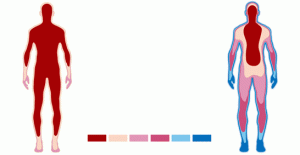By now you should have a much better idea on how to effectively manage the “front end” of your swim (cold water “priming”, mammalian diving reflex, etc.). This post will focus on managing the “back end” part with a special emphasis on the afterdrop phenomenon.
When you first enter the water and begin your swim, your body reacts by constricting the peripheral blood vessels in your arms and legs. This helps prevent heat loss by consolidating your body heat into your core. And as long as you continue with your physical activity, you will easily preserve a stable temperature.
However, once you end your swim and exit the water, your body sends your blood back to the skin to “warm up.” Because your skin is very cold at this point, your blood actually gets colder and is then recirculated back to your core. In essence, your core body temperature actually decreases during this rewarming period in a phenomenon known as the “afterdrop.”
There are two keys to managing the afterdrop:
1) When you end your swim workout, get out of the water right away. Don’t dally around and expose your skin to the cold water while your heart rate begins to drop.
2) Rewarm your core – not your periphery. This means placing warm, dry layers onto your torso and head and getting some hot liquid into your stomach to warm up your core from the inside. You may have cold hands and feet, but these are secondary concerns.
I typically remove the top part of my wetsuit and throw on a warm, long sleeve shirt or sweatshirt over my O’Neill Thermo. The Thermo does a great job of keeping the moisture away from my skin, so I usually keep it on underneath.
Just remember, the key to it all is to keep the heat in your head and torso.
